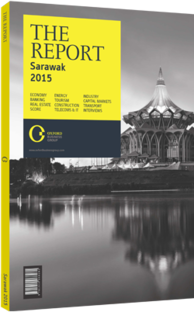Cargo and passenger movements increased throughout 2014 in Sarawak
As Sarawak is separated from Peninsular Malaysia by the South China Sea and from the rest of Borneo due to limited road connectivity, air travel is the primary means of transport for most of those travelling to and from the state. By far the busiest airport serving Sarawak is Kuching International Airport (KIA), its only international airport. This transit hub is supported by seven smaller domestic airports: Sibu, Mukah, Bintulu, Mulu, Marudi, Miri and Limbang.
All eight major international and domestic airports are managed by Malaysia Airports Holdings, which also runs the primary airports across the rest of the country, including Kuala Lumpur International Airport. Another 10 airstrips serve more remote locations in Sarawak, most of them deep in the interior where limited road access and rugged terrain prevent rapid and efficient ground travel.
DESTINATION SARAWAK: Sarawak’s air sector experienced moderate growth up to 2010 before a wave of infrastructure and industrial investment. Between 2010 and 2013, air traffic (excluding transit passengers) to and from the state ballooned by 33% from 7.1m to 9.42m, compared to a 9% increase from 6.21m to 6.76m passengers from 2006 to 2009, according to Ministry of Transportation statistics.
After annual traffic increased by 14% in 2013 this pace continued into 2014, with a total of 7.07m passengers travelling to and from Sarawak through the first three quarters of the year.
Due to KIA’s limited international offerings, the vast majority of Sarawak’s passengers continue to be travelling on domestic routes, and accounted for 8.95m of the 9.42m travellers in 2013.
In contrast to the growth in passenger numbers, air cargo levels have remained volatile as much of the new industrial development is taking place in coastal areas, which can easily and less-expensively accommodate large quantities of seagoing freight. From 2004 to 2013, air cargo traffic exceeded the 37,000-tonne level four times (2005, 2010, 2011 and 2013) but has yet to display consistent year-onyear (y-o-y) growth after peaking at 37,850 tonnes in 2010. Through the first three quarters of 2014 air cargo traffic totalled 29,390 tonnes.
CROWN JEWEL: The linchpin of Sarawak’s air transport network is KIA, which accommodates passengers and cargo entering the state while acting as a feeder for its smaller regional airports. Six airlines service KIA: AirAsia (with local flights plus a flight to Singapore); XpressAir (a flight to Pontianak, Indonesia), MAS (local flights plus flights to Hong Kong and Singapore), MASW ings, Malindo Air and SilkAir (to Singapore). The vast majority of flights travel to and from Kuala Lumpur, with 161 such flights scheduled weekly as of 2014, along with limited international routes, including 17 weekly to Singapore, seven to Hong Kong and nine to Pontianak.
In 2013 KIA recorded 4.87m passengers (a 16% increase on 2012), and 56,085 aircraft movements (a 20% rise on 2012), according to the Department of Statistics Malaysia. Passengers for 2014 were recorded at 2.42m in the first six months of the year, a further 6% y-o-y increase for that time period. With an annual capacity of 5.3m, KIA is nearing the upper threshold of its current capabilities, and will require further expansion in the immediate future. This is being addressed with the construction of a 3700-sq-metre expansion to the main terminal building, which is projected to accommodate an additional 300,000 passengers annually.
Kuching’s primary air transport hub also hosts five cargo airlines: DHL Aviation, Gading Sari Aviation Services, MAS kargo, Neptune Air and Transmile Air Services. Cargo passing through KIA shot up to 21,993 tonnes in 2013, a 39% rise on 2012, as investment in Sarawak rose. This trend continued in 2014, with cargo movement on course to exceed 2013 as of the end of the third quarter. The quantity of cargo shipped rose in each successive quarter, to 5.42m tonnes, 6.62m tonnes and 7.43m tonnes, respectively.
You have reached the limit of premium articles you can view for free.
Choose from the options below to purchase print or digital editions of our Reports. You can also purchase a website subscription giving you unlimited access to all of our Reports online for 12 months.
If you have already purchased this Report or have a website subscription, please login to continue.

